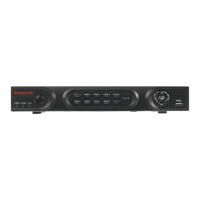
Do you have a question about the Honeywell HRGX41 and is the answer not in the manual?
| Video Input | 4 channels |
|---|---|
| Video Output | HDMI, VGA |
| Recording Resolution | Up to 1080p |
| Hard Drive Support | 1 SATA HDD |
| Hard Drive Capacity | Up to 6TB |
| Audio Output | 1 channel |
| Compression | H.264 |
| USB Interface | 2 USB 2.0 ports |
| Operating System | Embedded Linux |
| Motion Detection | Yes |
| Network Interface | RJ-45 10/100Mbps |
| Remote Viewing | Yes, via mobile app and web client |
| Operating Temperature | -10°C to +55°C (14°F to 131°F) |
| Audio Input | 4 channels |
Details FCC and Canadian compliance statements for the device.
States compliance with UL, CSA, EMC, and Low Voltage directives.
Provides essential safety guidelines for operating and installing the DVR.
Lists the chapters and topics covered in the HRGX DVR User Manual.
Lists the main features and capabilities of the HRGX DVR.
Details the front panel controls and indicators for different HRGX models.
Illustrates and describes the rear panel connectors for different HRGX models.
Explains how to use the mouse and IR remote for DVR setup and operation.
Provides steps for pairing the remote and common troubleshooting tips.
Presents a diagram of the DVR's menu hierarchy for navigation.
Covers installation guidelines and connecting external devices like cameras and monitors.
Procedures for powering on/off the DVR and initial configuration using the setup wizard.
Guides on accessing the main menu and setting system date and time.
Instructions for upgrading firmware and calculating HDD storage requirements.
Explains the live view mode, on-screen notifications, and quick setting toolbar.
Guides on setting screen layout, output modes, camera order, and channel-zero encoding.
Instructions for channel switching, output switching, and digital zooming.
Describes the on-screen interface for controlling PTZ cameras.
Sets up communication parameters between the DVR and PTZ camera.
Covers programming presets, patrols, patterns, and how to activate them.
Allows manual start/stop of recording from live view and manual recording settings.
Covers setting recording schedules, holiday schedules, encoding, and redundant recording.
Methods to lock recorded files or set HDDs to read-only to prevent overwriting.
Covers searching and viewing video by channel, time, event, tag, and system log.
Includes creating video clips, using tags, digital zoom, and smart search functionality.
Guides on saving full recorded video files and customized clips to external storage.
Sets up external sensor triggers and external alarm signal outputs.
Sets up motion, video tampering, and video loss detection alarms.
Covers device exceptions, email notifications, and remote alarm host settings.
Sets basic network parameters like IP address, DHCP, and ports.
Configures PPPoE, DDNS, NTP, SNMP, UPnP, and Multicast settings.
Monitors traffic, tests network delay, and exports network packets.
Checks the health, status, and capacity of installed hard disk drives.
Expands storage capacity by connecting NAS or SAN devices.
Organizes HDDs, sets quotas, and defines read-only or redundancy properties.
Covers SMART HDD self-tests, bad sector detection, and HDD alarm configurations.
Customizes the display of date, time, and camera name on the video feed.
Adjusts image parameters like brightness, contrast, and saturation for lighting conditions.
Conceals specific areas within the video feed to protect privacy.
Sets language, resolution, date/time, device name, and other system parameters.
Accesses details about the DVR, cameras, network, and HDD status.
Provides instructions for searching and exporting operation, alarm, and exception logs.
Enables exporting and importing DVR settings for backup or deployment.
Guides for updating DVR firmware and restoring factory default settings.
Describes Administrator, Operator, and Guest roles and their default permissions.
Provides procedures for creating, modifying, and removing user accounts.
Instructions for securely changing the DVR's administrative password.











